Airway and Adjunct Equipment for Mr Chan
VerifiedAdded on 2023/01/11
|8
|2561
|81
AI Summary
This assignment focuses on the appropriate airway and adjunct equipment and anaesthetic technique for Mr Chan, a patient with a fractured neck of femur. It also discusses the stages of anaesthesia and specific interventions to mitigate complications.
Contribute Materials
Your contribution can guide someone’s learning journey. Share your
documents today.
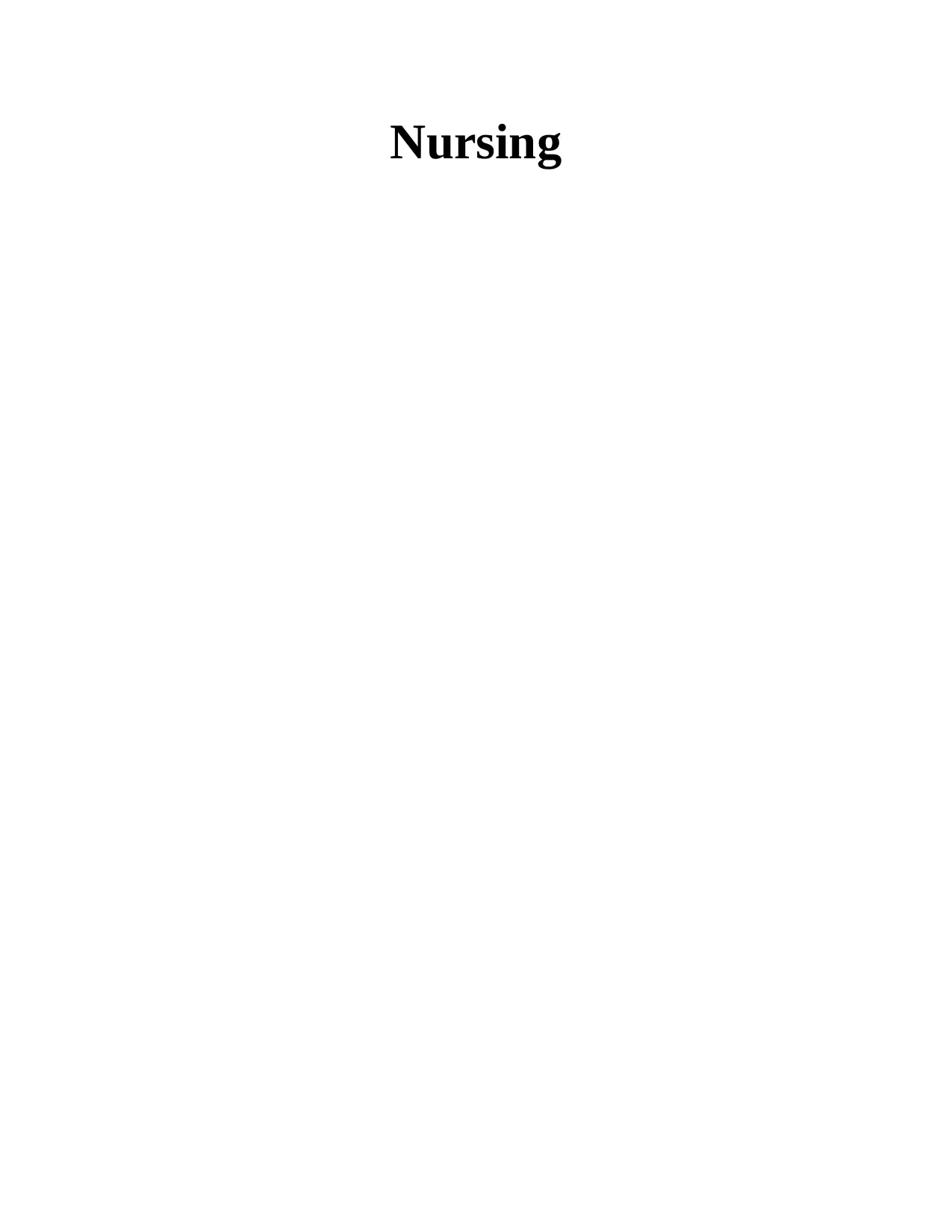
Nursing
Secure Best Marks with AI Grader
Need help grading? Try our AI Grader for instant feedback on your assignments.
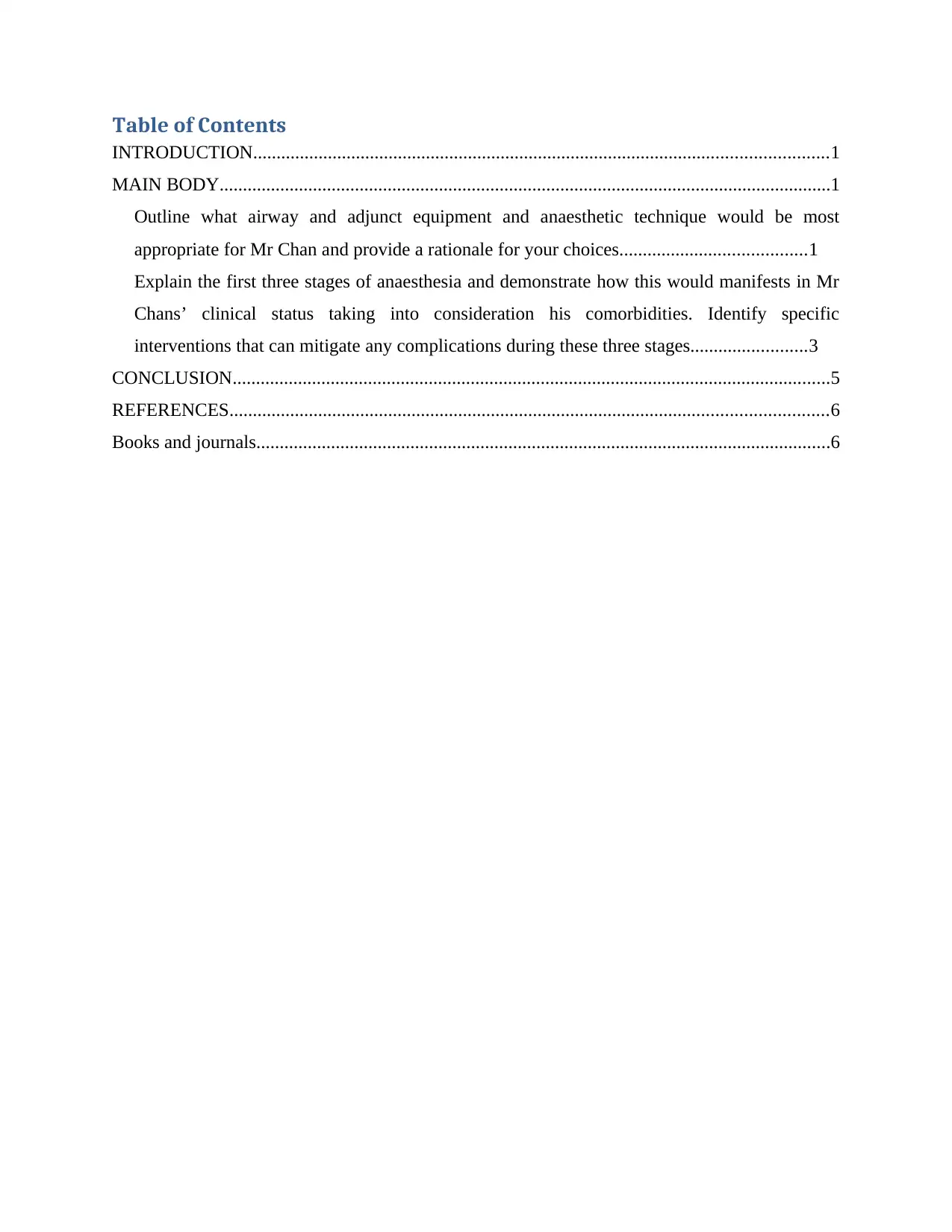
Table of Contents
INTRODUCTION...........................................................................................................................1
MAIN BODY...................................................................................................................................1
Outline what airway and adjunct equipment and anaesthetic technique would be most
appropriate for Mr Chan and provide a rationale for your choices........................................1
Explain the first three stages of anaesthesia and demonstrate how this would manifests in Mr
Chans’ clinical status taking into consideration his comorbidities. Identify specific
interventions that can mitigate any complications during these three stages.........................3
CONCLUSION................................................................................................................................5
REFERENCES................................................................................................................................6
Books and journals...........................................................................................................................6
INTRODUCTION...........................................................................................................................1
MAIN BODY...................................................................................................................................1
Outline what airway and adjunct equipment and anaesthetic technique would be most
appropriate for Mr Chan and provide a rationale for your choices........................................1
Explain the first three stages of anaesthesia and demonstrate how this would manifests in Mr
Chans’ clinical status taking into consideration his comorbidities. Identify specific
interventions that can mitigate any complications during these three stages.........................3
CONCLUSION................................................................................................................................5
REFERENCES................................................................................................................................6
Books and journals...........................................................................................................................6
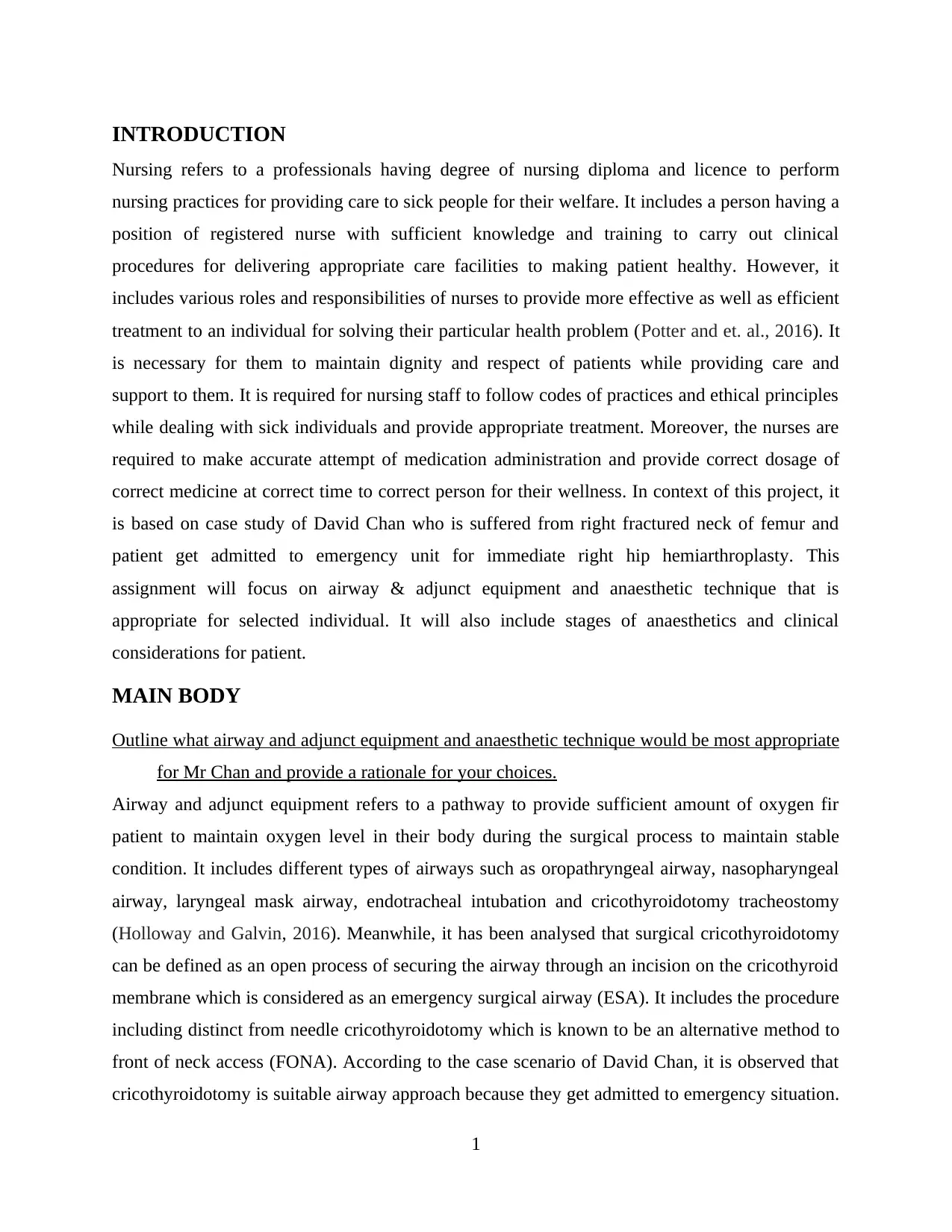
INTRODUCTION
Nursing refers to a professionals having degree of nursing diploma and licence to perform
nursing practices for providing care to sick people for their welfare. It includes a person having a
position of registered nurse with sufficient knowledge and training to carry out clinical
procedures for delivering appropriate care facilities to making patient healthy. However, it
includes various roles and responsibilities of nurses to provide more effective as well as efficient
treatment to an individual for solving their particular health problem (Potter and et. al., 2016). It
is necessary for them to maintain dignity and respect of patients while providing care and
support to them. It is required for nursing staff to follow codes of practices and ethical principles
while dealing with sick individuals and provide appropriate treatment. Moreover, the nurses are
required to make accurate attempt of medication administration and provide correct dosage of
correct medicine at correct time to correct person for their wellness. In context of this project, it
is based on case study of David Chan who is suffered from right fractured neck of femur and
patient get admitted to emergency unit for immediate right hip hemiarthroplasty. This
assignment will focus on airway & adjunct equipment and anaesthetic technique that is
appropriate for selected individual. It will also include stages of anaesthetics and clinical
considerations for patient.
MAIN BODY
Outline what airway and adjunct equipment and anaesthetic technique would be most appropriate
for Mr Chan and provide a rationale for your choices.
Airway and adjunct equipment refers to a pathway to provide sufficient amount of oxygen fir
patient to maintain oxygen level in their body during the surgical process to maintain stable
condition. It includes different types of airways such as oropathryngeal airway, nasopharyngeal
airway, laryngeal mask airway, endotracheal intubation and cricothyroidotomy tracheostomy
(Holloway and Galvin, 2016). Meanwhile, it has been analysed that surgical cricothyroidotomy
can be defined as an open process of securing the airway through an incision on the cricothyroid
membrane which is considered as an emergency surgical airway (ESA). It includes the procedure
including distinct from needle cricothyroidotomy which is known to be an alternative method to
front of neck access (FONA). According to the case scenario of David Chan, it is observed that
cricothyroidotomy is suitable airway approach because they get admitted to emergency situation.
1
Nursing refers to a professionals having degree of nursing diploma and licence to perform
nursing practices for providing care to sick people for their welfare. It includes a person having a
position of registered nurse with sufficient knowledge and training to carry out clinical
procedures for delivering appropriate care facilities to making patient healthy. However, it
includes various roles and responsibilities of nurses to provide more effective as well as efficient
treatment to an individual for solving their particular health problem (Potter and et. al., 2016). It
is necessary for them to maintain dignity and respect of patients while providing care and
support to them. It is required for nursing staff to follow codes of practices and ethical principles
while dealing with sick individuals and provide appropriate treatment. Moreover, the nurses are
required to make accurate attempt of medication administration and provide correct dosage of
correct medicine at correct time to correct person for their wellness. In context of this project, it
is based on case study of David Chan who is suffered from right fractured neck of femur and
patient get admitted to emergency unit for immediate right hip hemiarthroplasty. This
assignment will focus on airway & adjunct equipment and anaesthetic technique that is
appropriate for selected individual. It will also include stages of anaesthetics and clinical
considerations for patient.
MAIN BODY
Outline what airway and adjunct equipment and anaesthetic technique would be most appropriate
for Mr Chan and provide a rationale for your choices.
Airway and adjunct equipment refers to a pathway to provide sufficient amount of oxygen fir
patient to maintain oxygen level in their body during the surgical process to maintain stable
condition. It includes different types of airways such as oropathryngeal airway, nasopharyngeal
airway, laryngeal mask airway, endotracheal intubation and cricothyroidotomy tracheostomy
(Holloway and Galvin, 2016). Meanwhile, it has been analysed that surgical cricothyroidotomy
can be defined as an open process of securing the airway through an incision on the cricothyroid
membrane which is considered as an emergency surgical airway (ESA). It includes the procedure
including distinct from needle cricothyroidotomy which is known to be an alternative method to
front of neck access (FONA). According to the case scenario of David Chan, it is observed that
cricothyroidotomy is suitable airway approach because they get admitted to emergency situation.
1
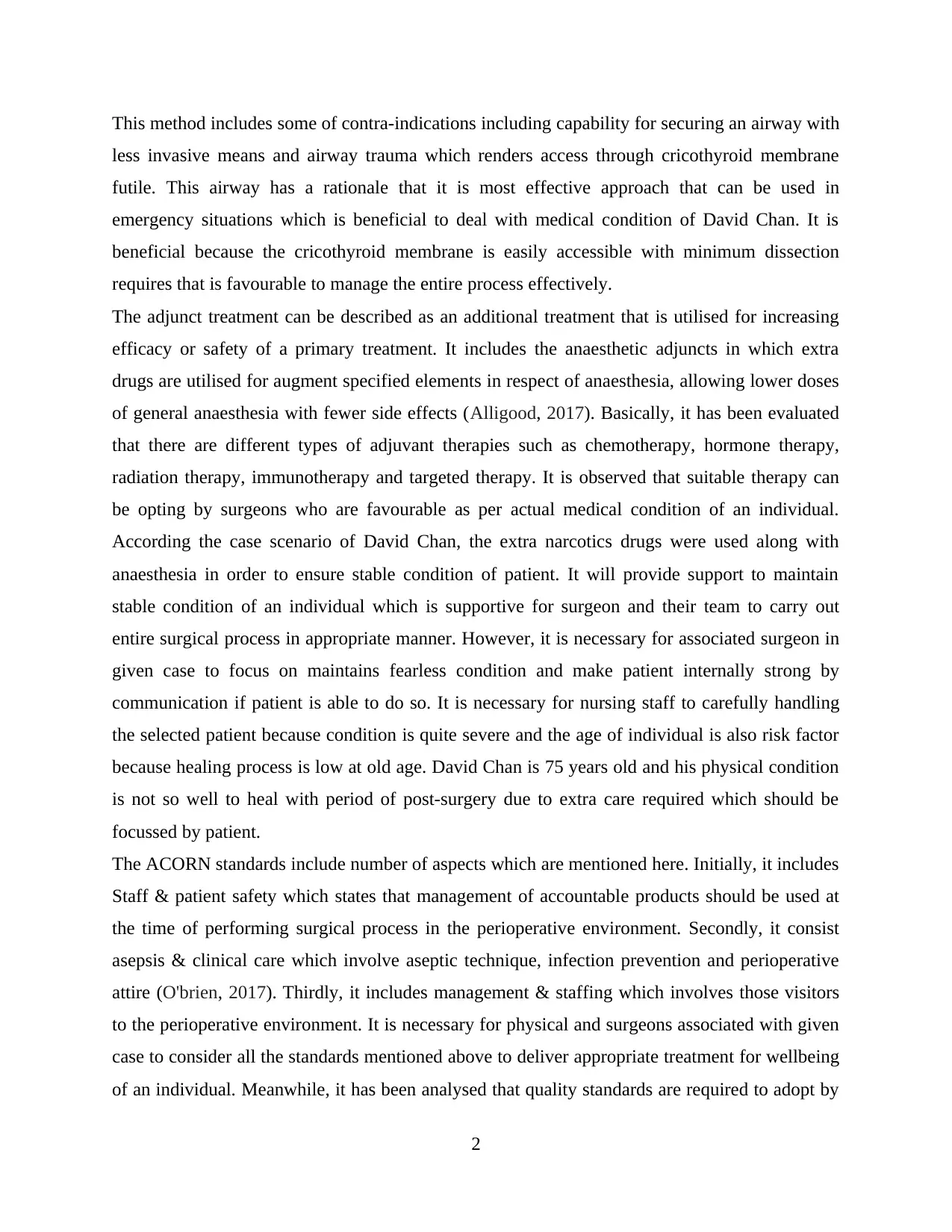
This method includes some of contra-indications including capability for securing an airway with
less invasive means and airway trauma which renders access through cricothyroid membrane
futile. This airway has a rationale that it is most effective approach that can be used in
emergency situations which is beneficial to deal with medical condition of David Chan. It is
beneficial because the cricothyroid membrane is easily accessible with minimum dissection
requires that is favourable to manage the entire process effectively.
The adjunct treatment can be described as an additional treatment that is utilised for increasing
efficacy or safety of a primary treatment. It includes the anaesthetic adjuncts in which extra
drugs are utilised for augment specified elements in respect of anaesthesia, allowing lower doses
of general anaesthesia with fewer side effects (Alligood, 2017). Basically, it has been evaluated
that there are different types of adjuvant therapies such as chemotherapy, hormone therapy,
radiation therapy, immunotherapy and targeted therapy. It is observed that suitable therapy can
be opting by surgeons who are favourable as per actual medical condition of an individual.
According the case scenario of David Chan, the extra narcotics drugs were used along with
anaesthesia in order to ensure stable condition of patient. It will provide support to maintain
stable condition of an individual which is supportive for surgeon and their team to carry out
entire surgical process in appropriate manner. However, it is necessary for associated surgeon in
given case to focus on maintains fearless condition and make patient internally strong by
communication if patient is able to do so. It is necessary for nursing staff to carefully handling
the selected patient because condition is quite severe and the age of individual is also risk factor
because healing process is low at old age. David Chan is 75 years old and his physical condition
is not so well to heal with period of post-surgery due to extra care required which should be
focussed by patient.
The ACORN standards include number of aspects which are mentioned here. Initially, it includes
Staff & patient safety which states that management of accountable products should be used at
the time of performing surgical process in the perioperative environment. Secondly, it consist
asepsis & clinical care which involve aseptic technique, infection prevention and perioperative
attire (O'brien, 2017). Thirdly, it includes management & staffing which involves those visitors
to the perioperative environment. It is necessary for physical and surgeons associated with given
case to consider all the standards mentioned above to deliver appropriate treatment for wellbeing
of an individual. Meanwhile, it has been analysed that quality standards are required to adopt by
2
less invasive means and airway trauma which renders access through cricothyroid membrane
futile. This airway has a rationale that it is most effective approach that can be used in
emergency situations which is beneficial to deal with medical condition of David Chan. It is
beneficial because the cricothyroid membrane is easily accessible with minimum dissection
requires that is favourable to manage the entire process effectively.
The adjunct treatment can be described as an additional treatment that is utilised for increasing
efficacy or safety of a primary treatment. It includes the anaesthetic adjuncts in which extra
drugs are utilised for augment specified elements in respect of anaesthesia, allowing lower doses
of general anaesthesia with fewer side effects (Alligood, 2017). Basically, it has been evaluated
that there are different types of adjuvant therapies such as chemotherapy, hormone therapy,
radiation therapy, immunotherapy and targeted therapy. It is observed that suitable therapy can
be opting by surgeons who are favourable as per actual medical condition of an individual.
According the case scenario of David Chan, the extra narcotics drugs were used along with
anaesthesia in order to ensure stable condition of patient. It will provide support to maintain
stable condition of an individual which is supportive for surgeon and their team to carry out
entire surgical process in appropriate manner. However, it is necessary for associated surgeon in
given case to focus on maintains fearless condition and make patient internally strong by
communication if patient is able to do so. It is necessary for nursing staff to carefully handling
the selected patient because condition is quite severe and the age of individual is also risk factor
because healing process is low at old age. David Chan is 75 years old and his physical condition
is not so well to heal with period of post-surgery due to extra care required which should be
focussed by patient.
The ACORN standards include number of aspects which are mentioned here. Initially, it includes
Staff & patient safety which states that management of accountable products should be used at
the time of performing surgical process in the perioperative environment. Secondly, it consist
asepsis & clinical care which involve aseptic technique, infection prevention and perioperative
attire (O'brien, 2017). Thirdly, it includes management & staffing which involves those visitors
to the perioperative environment. It is necessary for physical and surgeons associated with given
case to consider all the standards mentioned above to deliver appropriate treatment for wellbeing
of an individual. Meanwhile, it has been analysed that quality standards are required to adopt by
2
Secure Best Marks with AI Grader
Need help grading? Try our AI Grader for instant feedback on your assignments.
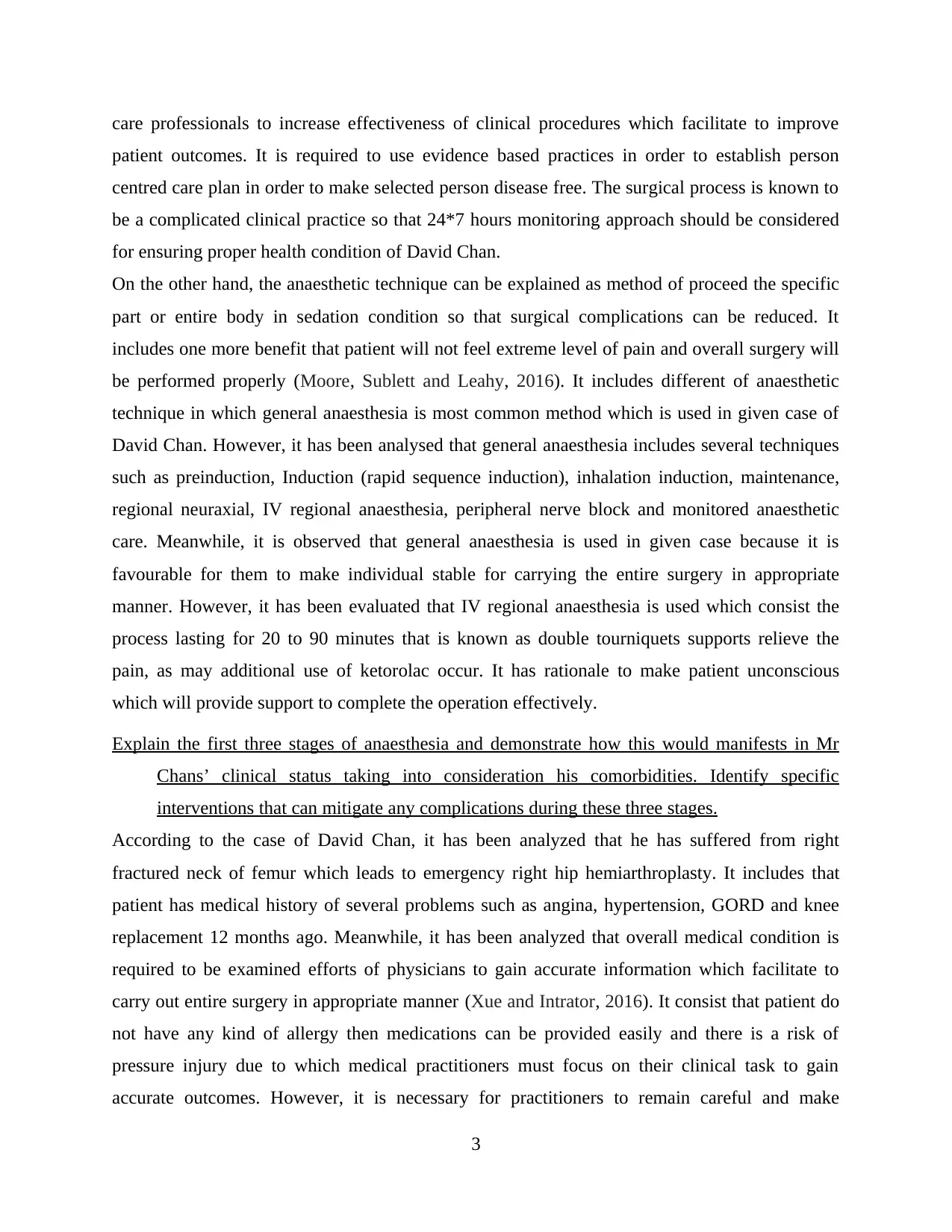
care professionals to increase effectiveness of clinical procedures which facilitate to improve
patient outcomes. It is required to use evidence based practices in order to establish person
centred care plan in order to make selected person disease free. The surgical process is known to
be a complicated clinical practice so that 24*7 hours monitoring approach should be considered
for ensuring proper health condition of David Chan.
On the other hand, the anaesthetic technique can be explained as method of proceed the specific
part or entire body in sedation condition so that surgical complications can be reduced. It
includes one more benefit that patient will not feel extreme level of pain and overall surgery will
be performed properly (Moore, Sublett and Leahy, 2016). It includes different of anaesthetic
technique in which general anaesthesia is most common method which is used in given case of
David Chan. However, it has been analysed that general anaesthesia includes several techniques
such as preinduction, Induction (rapid sequence induction), inhalation induction, maintenance,
regional neuraxial, IV regional anaesthesia, peripheral nerve block and monitored anaesthetic
care. Meanwhile, it is observed that general anaesthesia is used in given case because it is
favourable for them to make individual stable for carrying the entire surgery in appropriate
manner. However, it has been evaluated that IV regional anaesthesia is used which consist the
process lasting for 20 to 90 minutes that is known as double tourniquets supports relieve the
pain, as may additional use of ketorolac occur. It has rationale to make patient unconscious
which will provide support to complete the operation effectively.
Explain the first three stages of anaesthesia and demonstrate how this would manifests in Mr
Chans’ clinical status taking into consideration his comorbidities. Identify specific
interventions that can mitigate any complications during these three stages.
According to the case of David Chan, it has been analyzed that he has suffered from right
fractured neck of femur which leads to emergency right hip hemiarthroplasty. It includes that
patient has medical history of several problems such as angina, hypertension, GORD and knee
replacement 12 months ago. Meanwhile, it has been analyzed that overall medical condition is
required to be examined efforts of physicians to gain accurate information which facilitate to
carry out entire surgery in appropriate manner (Xue and Intrator, 2016). It consist that patient do
not have any kind of allergy then medications can be provided easily and there is a risk of
pressure injury due to which medical practitioners must focus on their clinical task to gain
accurate outcomes. However, it is necessary for practitioners to remain careful and make
3
patient outcomes. It is required to use evidence based practices in order to establish person
centred care plan in order to make selected person disease free. The surgical process is known to
be a complicated clinical practice so that 24*7 hours monitoring approach should be considered
for ensuring proper health condition of David Chan.
On the other hand, the anaesthetic technique can be explained as method of proceed the specific
part or entire body in sedation condition so that surgical complications can be reduced. It
includes one more benefit that patient will not feel extreme level of pain and overall surgery will
be performed properly (Moore, Sublett and Leahy, 2016). It includes different of anaesthetic
technique in which general anaesthesia is most common method which is used in given case of
David Chan. However, it has been analysed that general anaesthesia includes several techniques
such as preinduction, Induction (rapid sequence induction), inhalation induction, maintenance,
regional neuraxial, IV regional anaesthesia, peripheral nerve block and monitored anaesthetic
care. Meanwhile, it is observed that general anaesthesia is used in given case because it is
favourable for them to make individual stable for carrying the entire surgery in appropriate
manner. However, it has been evaluated that IV regional anaesthesia is used which consist the
process lasting for 20 to 90 minutes that is known as double tourniquets supports relieve the
pain, as may additional use of ketorolac occur. It has rationale to make patient unconscious
which will provide support to complete the operation effectively.
Explain the first three stages of anaesthesia and demonstrate how this would manifests in Mr
Chans’ clinical status taking into consideration his comorbidities. Identify specific
interventions that can mitigate any complications during these three stages.
According to the case of David Chan, it has been analyzed that he has suffered from right
fractured neck of femur which leads to emergency right hip hemiarthroplasty. It includes that
patient has medical history of several problems such as angina, hypertension, GORD and knee
replacement 12 months ago. Meanwhile, it has been analyzed that overall medical condition is
required to be examined efforts of physicians to gain accurate information which facilitate to
carry out entire surgery in appropriate manner (Xue and Intrator, 2016). It consist that patient do
not have any kind of allergy then medications can be provided easily and there is a risk of
pressure injury due to which medical practitioners must focus on their clinical task to gain
accurate outcomes. However, it is necessary for practitioners to remain careful and make
3

decision making about anesthesia by evaluating entire condition of patient. It will provide
support to use more effective as well as efficient method of anesthesia that is favorable for an
individual. However, the patient is required to be maintaining stable during the entire surgical
procedure due to which suitable anesthesia should be used properly. There are several stages of
anesthesia which are required to be analyzed which are mentioned below.
Stage 1: Stage of analgesia or disorientation – This includes the condition that is responsible to
start from induction of general anesthesia to loss of consciousness. It includes the attempt of
providing anesthesia which impact on patient to make them unconscious so that entire surgical
process of surgery can be carried out properly (Bianchi and et. al., 2018). In context of given
case, the anesthesia is required to be provided to David Chan before conducting the process of
surgical methods that is emergency right hip hemiarthroplasty.
Stage 2: Stage of excitement or delirium – This can be considered as second stage of anesthesia
which begin form the state of losing the consciousness to the onset of automatic breathing. It
includes the condition when eyelash reflex disappear but other reflexes remain intact as well as
coughing, vomiting and struggling may occur with patient. It has been analyzed that respiration
can be irregular with breath holding in given case scenario related to David Chan suffering from
right fractured neck of femur leading to emergency right hip hemiarthroplasty.
Stage 3: Stage of surgical anesthesia – This involves the situation started from onset of automatic
respiration to the respiratory paralysis which can be further divided into four planes that are
explained here. Initially, it includes plane 1 consist when onset of automatic respiration to
cessation of eyeball movements. In this, it is observed that eyelid reflex is lost along with
disappeared swallowing reflex and marked movement of eyeball that may take place. It includes
that conjunctival reflex is lost at the bottom of the plane. Secondly, the plane II includes the
condition occurred from cessation of eyeball movements to beginning of paralysis of intercostal
muscles. It consist the laryngeal reflex that is lost although inflammation of the upper respiratory
tract increases reflex irritability, corneal reflex disappears, secretion of tears which increases that
is known as a useful sign of light anesthesia (Holmes and et. al., 2016). However, it has been
analyzed that it consist the condition when respiration is an automatic and regular, moment and
deep breathing as a response to skin stimulation disappears. In addition to this, plane III includes
the situation which is responsible for starting from completion of intercostal muscle paralysis. It
involves that diaphragmatic respiration persists but there is progressive intercostal paralysis that
4
support to use more effective as well as efficient method of anesthesia that is favorable for an
individual. However, the patient is required to be maintaining stable during the entire surgical
procedure due to which suitable anesthesia should be used properly. There are several stages of
anesthesia which are required to be analyzed which are mentioned below.
Stage 1: Stage of analgesia or disorientation – This includes the condition that is responsible to
start from induction of general anesthesia to loss of consciousness. It includes the attempt of
providing anesthesia which impact on patient to make them unconscious so that entire surgical
process of surgery can be carried out properly (Bianchi and et. al., 2018). In context of given
case, the anesthesia is required to be provided to David Chan before conducting the process of
surgical methods that is emergency right hip hemiarthroplasty.
Stage 2: Stage of excitement or delirium – This can be considered as second stage of anesthesia
which begin form the state of losing the consciousness to the onset of automatic breathing. It
includes the condition when eyelash reflex disappear but other reflexes remain intact as well as
coughing, vomiting and struggling may occur with patient. It has been analyzed that respiration
can be irregular with breath holding in given case scenario related to David Chan suffering from
right fractured neck of femur leading to emergency right hip hemiarthroplasty.
Stage 3: Stage of surgical anesthesia – This involves the situation started from onset of automatic
respiration to the respiratory paralysis which can be further divided into four planes that are
explained here. Initially, it includes plane 1 consist when onset of automatic respiration to
cessation of eyeball movements. In this, it is observed that eyelid reflex is lost along with
disappeared swallowing reflex and marked movement of eyeball that may take place. It includes
that conjunctival reflex is lost at the bottom of the plane. Secondly, the plane II includes the
condition occurred from cessation of eyeball movements to beginning of paralysis of intercostal
muscles. It consist the laryngeal reflex that is lost although inflammation of the upper respiratory
tract increases reflex irritability, corneal reflex disappears, secretion of tears which increases that
is known as a useful sign of light anesthesia (Holmes and et. al., 2016). However, it has been
analyzed that it consist the condition when respiration is an automatic and regular, moment and
deep breathing as a response to skin stimulation disappears. In addition to this, plane III includes
the situation which is responsible for starting from completion of intercostal muscle paralysis. It
involves that diaphragmatic respiration persists but there is progressive intercostal paralysis that
4
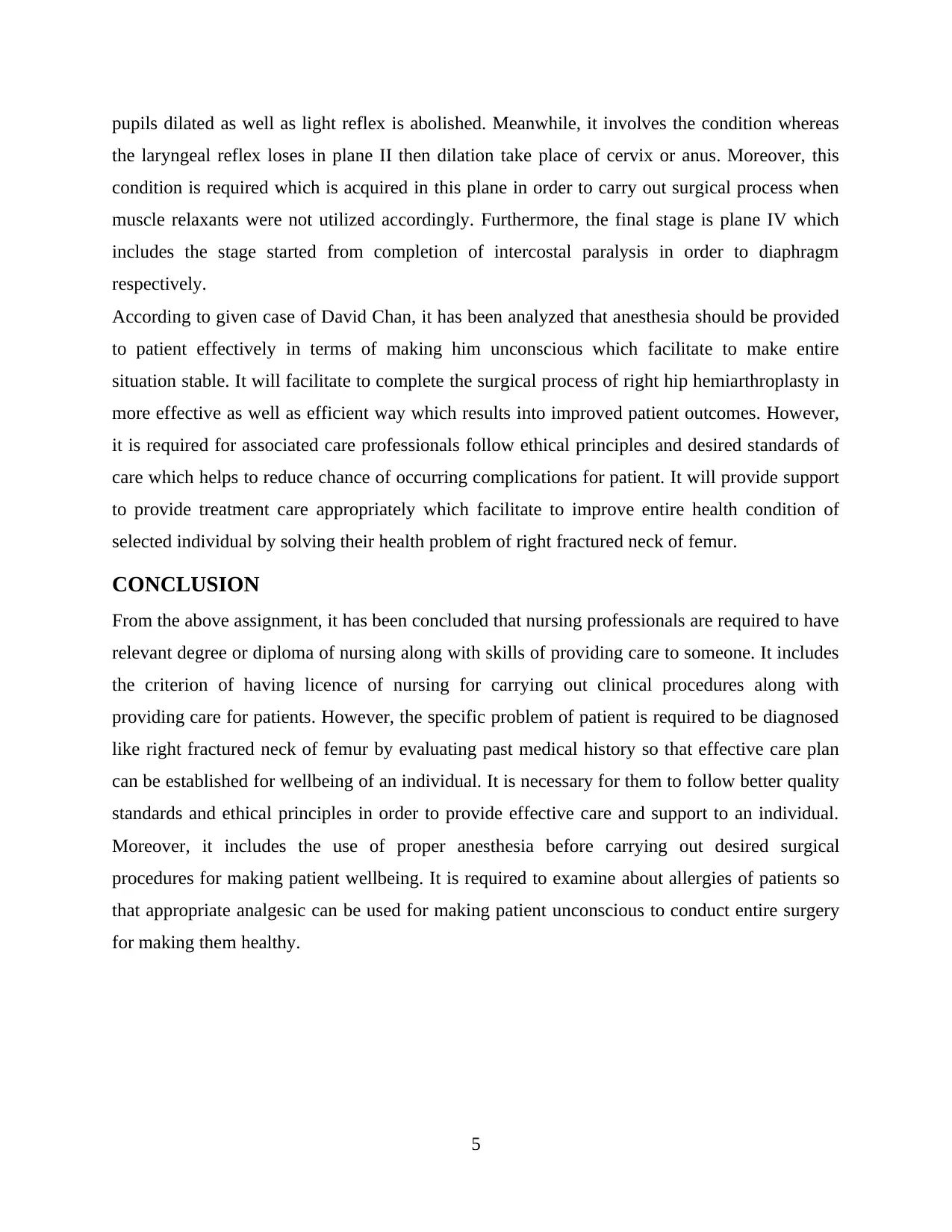
pupils dilated as well as light reflex is abolished. Meanwhile, it involves the condition whereas
the laryngeal reflex loses in plane II then dilation take place of cervix or anus. Moreover, this
condition is required which is acquired in this plane in order to carry out surgical process when
muscle relaxants were not utilized accordingly. Furthermore, the final stage is plane IV which
includes the stage started from completion of intercostal paralysis in order to diaphragm
respectively.
According to given case of David Chan, it has been analyzed that anesthesia should be provided
to patient effectively in terms of making him unconscious which facilitate to make entire
situation stable. It will facilitate to complete the surgical process of right hip hemiarthroplasty in
more effective as well as efficient way which results into improved patient outcomes. However,
it is required for associated care professionals follow ethical principles and desired standards of
care which helps to reduce chance of occurring complications for patient. It will provide support
to provide treatment care appropriately which facilitate to improve entire health condition of
selected individual by solving their health problem of right fractured neck of femur.
CONCLUSION
From the above assignment, it has been concluded that nursing professionals are required to have
relevant degree or diploma of nursing along with skills of providing care to someone. It includes
the criterion of having licence of nursing for carrying out clinical procedures along with
providing care for patients. However, the specific problem of patient is required to be diagnosed
like right fractured neck of femur by evaluating past medical history so that effective care plan
can be established for wellbeing of an individual. It is necessary for them to follow better quality
standards and ethical principles in order to provide effective care and support to an individual.
Moreover, it includes the use of proper anesthesia before carrying out desired surgical
procedures for making patient wellbeing. It is required to examine about allergies of patients so
that appropriate analgesic can be used for making patient unconscious to conduct entire surgery
for making them healthy.
5
the laryngeal reflex loses in plane II then dilation take place of cervix or anus. Moreover, this
condition is required which is acquired in this plane in order to carry out surgical process when
muscle relaxants were not utilized accordingly. Furthermore, the final stage is plane IV which
includes the stage started from completion of intercostal paralysis in order to diaphragm
respectively.
According to given case of David Chan, it has been analyzed that anesthesia should be provided
to patient effectively in terms of making him unconscious which facilitate to make entire
situation stable. It will facilitate to complete the surgical process of right hip hemiarthroplasty in
more effective as well as efficient way which results into improved patient outcomes. However,
it is required for associated care professionals follow ethical principles and desired standards of
care which helps to reduce chance of occurring complications for patient. It will provide support
to provide treatment care appropriately which facilitate to improve entire health condition of
selected individual by solving their health problem of right fractured neck of femur.
CONCLUSION
From the above assignment, it has been concluded that nursing professionals are required to have
relevant degree or diploma of nursing along with skills of providing care to someone. It includes
the criterion of having licence of nursing for carrying out clinical procedures along with
providing care for patients. However, the specific problem of patient is required to be diagnosed
like right fractured neck of femur by evaluating past medical history so that effective care plan
can be established for wellbeing of an individual. It is necessary for them to follow better quality
standards and ethical principles in order to provide effective care and support to an individual.
Moreover, it includes the use of proper anesthesia before carrying out desired surgical
procedures for making patient wellbeing. It is required to examine about allergies of patients so
that appropriate analgesic can be used for making patient unconscious to conduct entire surgery
for making them healthy.
5
Paraphrase This Document
Need a fresh take? Get an instant paraphrase of this document with our AI Paraphraser
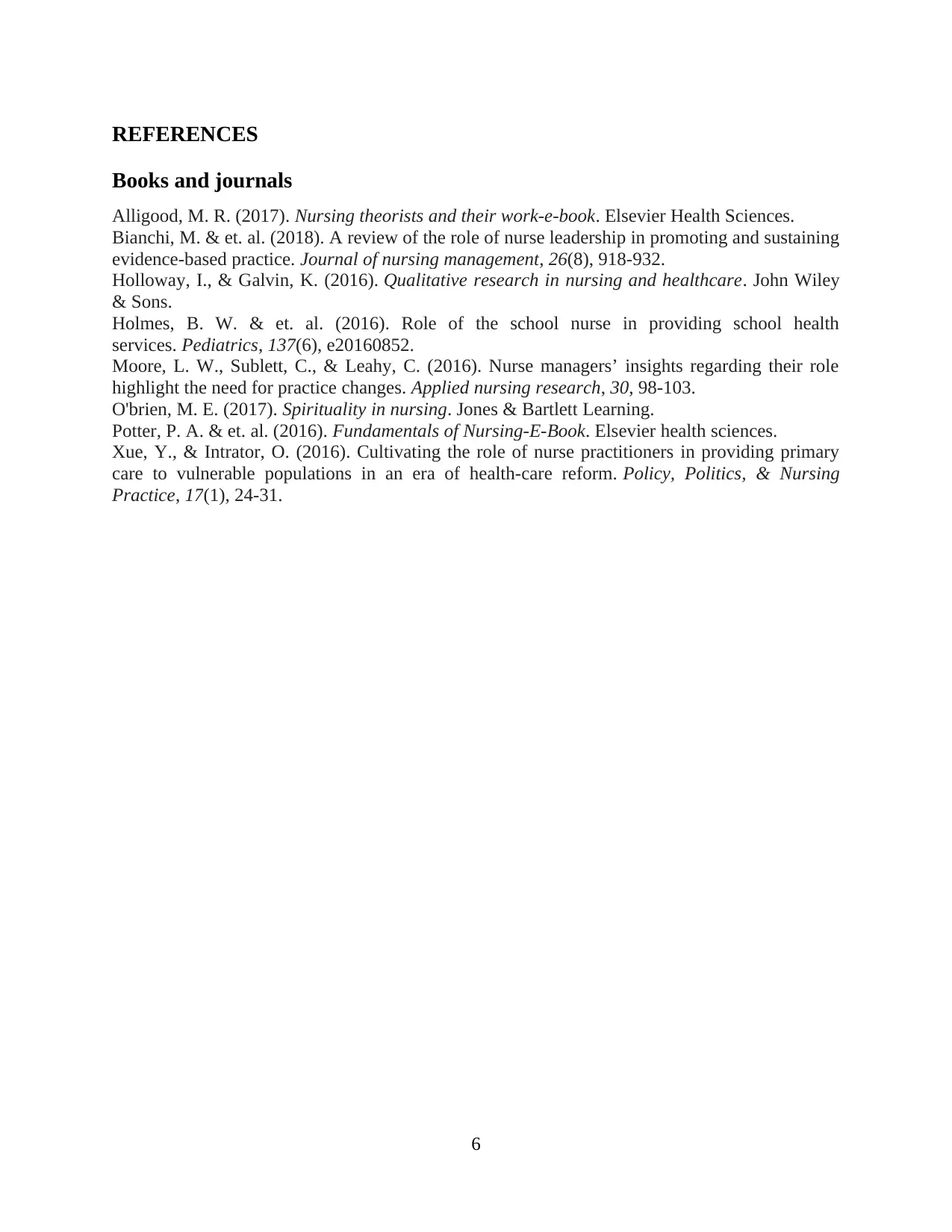
REFERENCES
Books and journals
Alligood, M. R. (2017). Nursing theorists and their work-e-book. Elsevier Health Sciences.
Bianchi, M. & et. al. (2018). A review of the role of nurse leadership in promoting and sustaining
evidence‐based practice. Journal of nursing management, 26(8), 918-932.
Holloway, I., & Galvin, K. (2016). Qualitative research in nursing and healthcare. John Wiley
& Sons.
Holmes, B. W. & et. al. (2016). Role of the school nurse in providing school health
services. Pediatrics, 137(6), e20160852.
Moore, L. W., Sublett, C., & Leahy, C. (2016). Nurse managers’ insights regarding their role
highlight the need for practice changes. Applied nursing research, 30, 98-103.
O'brien, M. E. (2017). Spirituality in nursing. Jones & Bartlett Learning.
Potter, P. A. & et. al. (2016). Fundamentals of Nursing-E-Book. Elsevier health sciences.
Xue, Y., & Intrator, O. (2016). Cultivating the role of nurse practitioners in providing primary
care to vulnerable populations in an era of health-care reform. Policy, Politics, & Nursing
Practice, 17(1), 24-31.
6
Books and journals
Alligood, M. R. (2017). Nursing theorists and their work-e-book. Elsevier Health Sciences.
Bianchi, M. & et. al. (2018). A review of the role of nurse leadership in promoting and sustaining
evidence‐based practice. Journal of nursing management, 26(8), 918-932.
Holloway, I., & Galvin, K. (2016). Qualitative research in nursing and healthcare. John Wiley
& Sons.
Holmes, B. W. & et. al. (2016). Role of the school nurse in providing school health
services. Pediatrics, 137(6), e20160852.
Moore, L. W., Sublett, C., & Leahy, C. (2016). Nurse managers’ insights regarding their role
highlight the need for practice changes. Applied nursing research, 30, 98-103.
O'brien, M. E. (2017). Spirituality in nursing. Jones & Bartlett Learning.
Potter, P. A. & et. al. (2016). Fundamentals of Nursing-E-Book. Elsevier health sciences.
Xue, Y., & Intrator, O. (2016). Cultivating the role of nurse practitioners in providing primary
care to vulnerable populations in an era of health-care reform. Policy, Politics, & Nursing
Practice, 17(1), 24-31.
6
1 out of 8
Related Documents
Your All-in-One AI-Powered Toolkit for Academic Success.
+13062052269
info@desklib.com
Available 24*7 on WhatsApp / Email
![[object Object]](/_next/static/media/star-bottom.7253800d.svg)
Unlock your academic potential
© 2024 | Zucol Services PVT LTD | All rights reserved.




